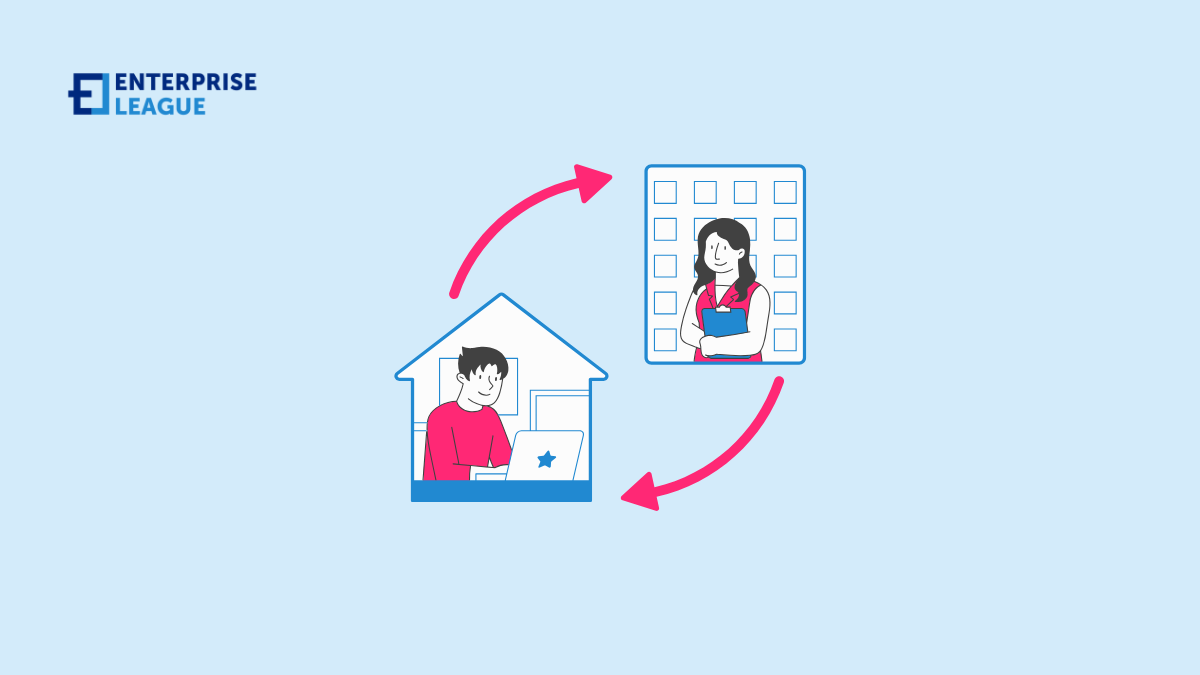The way we work has changed dramatically in recent years, and now companies have more choices about how to structure their workday. With some teams spread across the globe while others stick to traditional offices, and many try to find the sweet spot in between, the workplace nowadays looks totally different. With job seekers now asking about work arrangements before they even discuss salary, getting your work model right is something you simply can’t ignore.
Whether you’re running a business or just trying to understand your options better, we’ll walk you through the ins and outs of modern work arrangements, from fully remote to hybrid to traditional office setups.
Definitions of work models
Before diving into specific work arrangements, let’s get clear on what these different work models actually mean. The business world loves its buzzwords, and terms like “hybrid” or “remote-first” get thrown around a lot.
However, understanding the exact meaning of each model is crucial since it helps you make better decisions about what might work for your team and avoid confusion down the road. Here’s a breakdown of the most common work models you’ll encounter:
In-person work
In-person work refers to the traditional model where employees perform their duties full-time at a physical location, such as an office, store, or factory. This arrangement typically involves fixed schedules and daily commutes. In-person work remains relevant to industries that need face-to-face interactions or specialized on-site equipment.
Examples include retail, healthcare, manufacturing, and many traditional office settings. This model encourages direct supervision, immediate collaboration, and a clear separation between work and personal life.
Remote work
Remote work enables employees to perform their duties outside a central workplace, such as their home, a co-working space, or even a different country. This model suits roles where tasks can be completed independently or through virtual collaboration. Examples include content creation, IT roles, customer support, and digital marketing.
Remote work provides unmatched flexibility, allowing employees to manage their schedules and avoid commuting. If you’re looking to work remotely but struggling to find opportunities, consider freelance writer opportunities or other contract, short-term, or casual roles, many offer remote options.
Success in remote roles requires self-discipline, effective communication, and reliable technology.
Hybrid work
Hybrid work combines in-person and remote work, allowing employees the flexibility to do a bit of both. This model typically involves a mix of scheduled office and work-from-home days, accommodating diverse work styles and preferences.
For example, teams may spend certain days collaborating in the office while working remotely the rest of the week. Hybrid work can enhance employee satisfaction by providing the benefits of both models, such as in-person collaboration and the flexibility of remote work.
Advantages and drawbacks of each model
Each work model comes with its own mix of benefits and challenges, there’s no perfect one-size-fits-all solution. What works brilliantly for someone might be a disaster for another. Understanding these pros and cons helps you make smarter choices about which model fits your team’s needs, culture, and goals. Let’s break down what you can expect from each approach:
In-person work
The advantages of in-person work include easier collaboration and communication, as face-to-face interactions enable quick problem-solving and idea-sharing. It promotes stronger team bonding and culture-building through daily interactions and shared experiences. Employees have direct access to on-site resources, equipment, and immediate support from colleagues.
In-person work also provides a clear separation between work and home life, which some find beneficial for maintaining focus and work-life balance.
The drawbacks of in-person work include reduced flexibility, making it less appealing to employees seeking work-life balance. Long commutes can increase stress and take time away from personal or family responsibilities.
Remote work
Remote work presents numerous advantages, such as greater employee flexibility and autonomy. Working from home eliminates commuting time and costs, allowing individuals to create a healthy work environment that suits their preferences.
This flexibility can improve work-life balance, enabling employees to manage personal responsibilities alongside their professional obligations. For organizations, remote work opens access to a broader talent pool, as geographical limitations are less of a factor.
Remote work also has its challenges. Employees may experience feelings of isolation and disconnect from their colleagues, which can affect team dynamics. Additionally, maintaining effective communication and accountability can be more difficult in a remote setting, requiring deliberate efforts to promote connection and collaboration.
Hybrid work
Hybrid work combines the advantages of in-person and remote work, offering employees flexibility while encouraging collaboration. This model supports diverse work styles, allowing individuals to choose where they are most productive, whether in the office or at home. Many employees report increased job satisfaction and productivity when they can work in a way that suits their preferences.
However, hybrid work also has drawbacks. It requires careful scheduling and coordination to ensure all team members are on the same page. Additionally, there is a risk of creating an imbalance if remote workers feel excluded or less engaged compared to their in-office counterparts.
Factors to consider when choosing a model
What works brilliantly for someone might be a disaster for another and that’s why understanding these pros and cons is crucial. So, without further ado, let’s break down what you can expect from each business model before choosing the one that fits you:
For individuals
Consider how each option meets your lifestyle and goals when deciding on a work model. If maintaining a work-life balance is a priority, remote or hybrid work may offer the flexibility you need. However, in-person work might be a better fit if you thrive on structure and collaboration.
Evaluate your productivity in different environments. Some people excel in the quiet of a home office, while others need the energy of a bustling workplace to stay motivated. Additionally, assess career development opportunities—are there chances for networking, mentorship, or skill-building in the work model you’re considering?
For organizations
Organizations must evaluate several factors when determining the most suitable work model for their teams. The nature of work is crucial, some roles require physical presence, while others can be performed remotely. Assess how different models impact team dynamics, communication effectiveness, and company culture.
Evaluate the technological infrastructure needed to support various work arrangements, ensuring all employees have equal access to necessary tools and information. Consider the potential impact on productivity, employee satisfaction, and talent retention.
Financial implications should be analyzed, such as office space costs versus technology investments for remote work. Legal and compliance issues, including workplace safety and data security, must be addressed for each model. Organizations should also consider their long-term strategy and how different work models align with their goals for growth, innovation, and market positioning.
Conclusion
There’s no one-size-fits-all approach to work models, the best choice depends on individual needs, organizational goals, and the nature of the work itself. Employees and employers can make informed decisions by understanding the advantages and drawbacks of in-person, remote, and hybrid models.
Consider experimenting with different arrangements to find what works best for you or your organization. The right model should ultimately enhance work productivity, satisfaction, and overall well-being while meeting business objectives.
More must-read stories from Enterprise League:
- Things to consider before deciding on a business location.
- What’s the secret to running successful cold email campaigns?
- Getting your product in stores doesn’t have to be complicated.
- Innovative small business growth tips that will take you to the next level.
- Entrepreneurs over 70 that have defiled old age.
Related Articles
Workplace Violence or Drug Accusations: Protecting Yourself Legally
Accusations of workplace violence or drug-related misconduct can derail a career, even when the claims are unfounded. A single allegation can lead to suspension, internal investigations, damaged professional relationships, and in serious cases, criminal charges....
Workers’ Compensation Costs for Factory and Warehouse Forklift Accidents
Forklifts play a central role in day-to-day operations across factories and warehouses, but they also create a significant risk of injury. When a forklift overturns, strikes a pedestrian, or drops a load, the financial impact reaches far beyond the immediate medical...
Delayed Construction Injury Reports: Impact on Workers’ Comp
Construction work carries unavoidable risks, which is why workers' compensation exists to protect employees after an injury. But one factor can alter the entire outcome of a claim: delayed reporting. In the construction industry, where injuries often occur in...
Workplace Violence or Drug Accusations: Protecting Yourself Legally
Accusations of workplace violence or drug-related misconduct can derail a career, even when the claims are unfounded. A single allegation can lead to suspension, internal investigations, damaged professional relationships, and in serious cases, criminal charges....
Workers’ Compensation Costs for Factory and Warehouse Forklift Accidents
Forklifts play a central role in day-to-day operations across factories and warehouses, but they also create a significant risk of injury. When a forklift overturns, strikes a pedestrian, or drops a load, the financial impact reaches far beyond the immediate medical...






